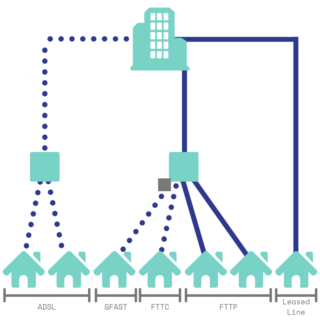Broadband Breakdown: What are the Different Types of Broadband?
We’re sure you’ve heard of ‘fibre’ and ‘superfast broadband’ many times already. But what does it actually mean? We’re here to break down the different types of broadband for you.
A Summary of Broadband Background
The most popular way of connecting to broadband used to be ADSL (asymmetric digital subscriber line). This used copper lines, and worked in conjunction with the telephone system to transmit data.
However, the ever increasing demand for internet meant that this old technology was no longer sufficient for most. Poor connections created frustrations for users and slow speeds hampered productivity. A new solution providing increased reliability was the only option. That’s where fibre comes in.
Fibre is the newest generation of broadband technology, and there are multiple ways of implementing it into the existing infrastructure. It is currently being rolled out to millions of homes and businesses across the UK, to provide a faster and more reliable internet connection.
You can see the different types of broadband outlined below.

ADSL (traditional broadband)
ADSL lines use copper from the exchange to the cabinet, and again from the cabinet to the premises. However, copper is not the most reliable material. The speed of the connection reduces over the distance travelled, so the further you are from the cabinet, the slower the speed of your connection. It is also subject to wear and tear, and damaged lines can further impact the connection.
Traditional broadband has max speeds of around 17Mbps. This is often considered slow, especially for businesses, with the amount of data that modern technology requires.
FTTC (Fibre to the Cabinet)
This is where fibre cables run from the exchange into the local cabinet. Traditional copper lines then share this connection out to the surrounding premises. While this technology is an improvement on traditional ADSL lines, it’s still not optimal for most people’s data requirements.
FTTC can reach speeds of around 80Mbps. This is sufficient for many, but in terms of supporting streaming, gaming, cloud systems and smart homes, it doesn’t always cut the mustard.
Gfast
Gfast is a technology that works in addition to FTTC. Openreach use a pod on the side of the cabinet that boosts the copper wire running to your premises. The result is that you can achieve faster speeds with a more reliable connection than you see with just FTTC.
Reaching speeds of around 330Mbps, this supports more devices at once so that everyone can go about their business, with less connectivity issues.
FTTP (Fibre to the Premises)
This technology removes the old ADSL copper technology from the equation. In addition to fibre lines running from the exchange to the cabinet, they also carry the connection from the cabinet straight to the premises.
You might simply want a full fibre connection at home so that you can stream Netflix to your heart’s content, while the kids play on the latest games console. With more items becoming ‘smart’ in the home too, a faster, more reliable connection can also help to support that.
For businesses, the availability of FTTP is even more crucial. With speeds of up to 330Mbps, and increased reliability, it provides an option for connectivity that is significantly better than ADSL, with a cost that’s a fraction of what you’d pay for a leased line. This means that you will be able to run a VoIP system in your office and work efficiently on the cloud, without sluggish internet speeds creating issues.
Leased Lines
Leased lines can provide a completely dedicated connection with high levels of uptime, fast repairs and backup options. While this can be a costly solution, they are very well suited to larger businesses.
The biggest difference between the broadband options above and leased lines is that this connection is dedicated. While other connections can support multiple premises, a leased line is solely yours.
Contention ratio refers to how much your internet line is shared with others in your area. In essence, your local cabinet or exchange could be sharing the internet speed across 50 premises/homes. In this example, that would mean a contention ratio of 50:1. A dedicated leased line eliminates this competition and guarantees your internet speed isn’t shared.
There are multiple leased lines options available, using both copper and fibre, the latter providing incredible speeds of up to 1Gbps. You can find out more about leased lines here.
There is a wide range of options for getting your business connected. This post simply covers some of the most popular types of broadband. Hopefully, you have gained a better understanding of what option would suit you better. If in doubt, you can simply give us a call.
Posted on 13/08/2019 by Roda
- Previous Post
- Next Post
Sign up to receive updates from Roda
Roda is a trading name of Roda Telecom Limited. Registered in England and Wales No.03640281.


